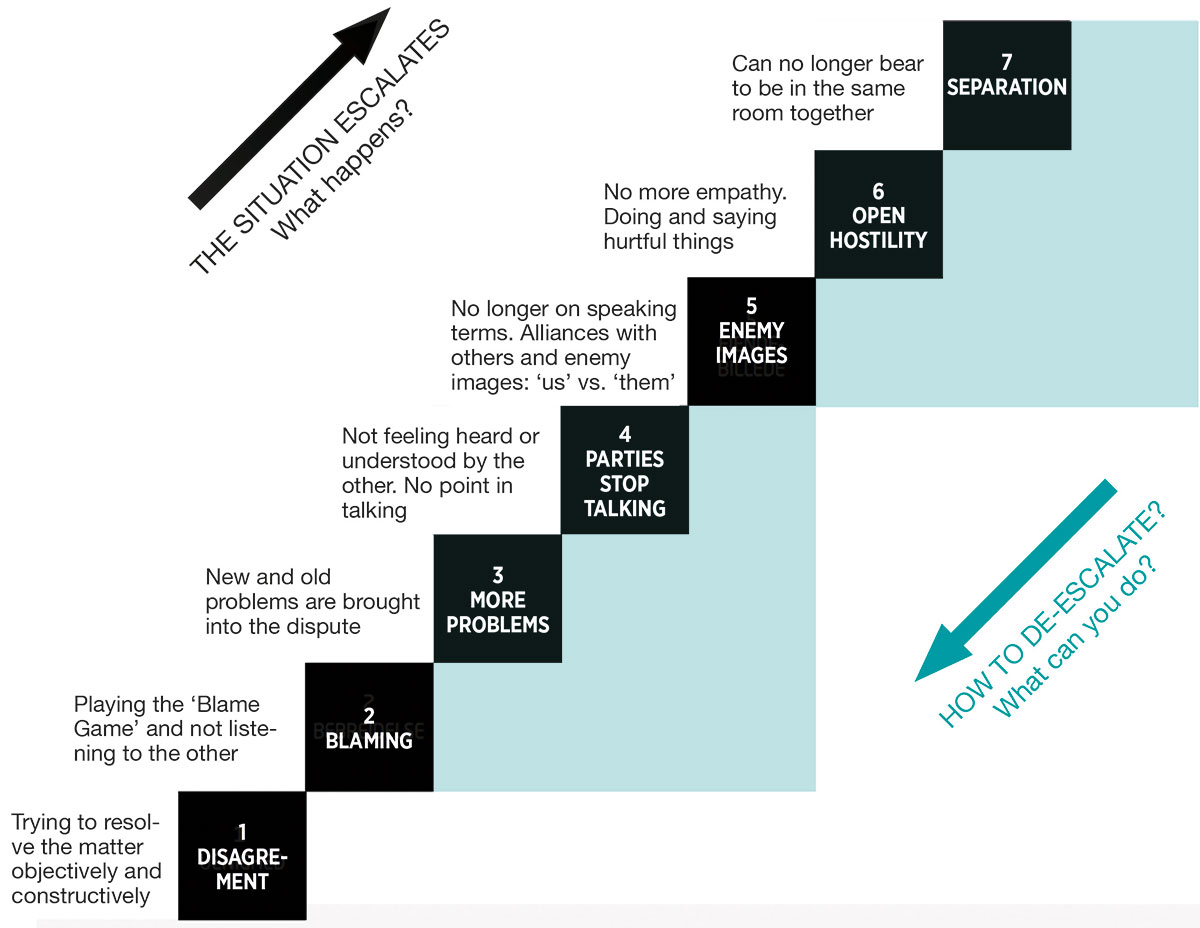Often, a conflict will escalate and worsen if no one takes initiative to do something actively to de-escalate it. The more we know about conflicts and why they occur and how they can be de-escalated; the greater our possibilities for managing the conflict.
Use the conflict ladder to understand how conflicts escalate, and what happens in conflict situations.

Step 1: Disagreement (the issue at hand): First, there is a disagreement. The parties are okay about disagreeing and find it interesting to discuss. If the parties discuss the issue without becoming emotionally involved, there will be no conflict.
- Solutions: The parties can resolve the disagreement on their own by being curious about each other’s views and motives, and by not becoming personal. But there’s a fine line between this and the next step, at which focus shifts from ‘the issue at hand’ to ‘the other person’.
Step 2: Blaming (the other person): There’s a shift of focus: now it’s no longer about the issue; it’s about the other person. The parties become personal and start to blame each other. Officially, the dispute is still about the issue, but the issue is now merely a pretext to point out the other person’s shortcomings and imperfections. Both parties are defending themselves and blaming the other. None of them feel listened to or understood by the other party.
- Solutions: The manager can help to de-escalate the conflict by intervening as a neutral mediator.
Step 3: More problems are brought into the discussion: The parties bring more problems into the discussion. Previous disagreements or conflicts are used to make generalising statements about the other. The parties no longer have a real interest in understanding each other. They are preoccupied with finding weaknesses in the other party’s arguments and defending their own.
- Solutions: The parties need support from the manager or from colleagues or an employee representative to de-escalate the conflict.
Step 4: The parties stop talking: The parties stop talking to each other. They see no point in talking anymore, and they feel the other person is impossible to talk to or be in the same room with.
- Solutions: This is the last chance to resolve the conflict before the relationship between the two colleagues is damaged more permanently. After this, it will be exceedingly difficult to re-establish a good collaborative relationship. A neutral person, who has been trained in conflict management, could act as a mediator.
Step 5: Enemy images: Both parties develop an enemy image of the other. The conflict doesn’t go way even though the parties are no longer on speaking terms. On the contrary, the parties feel a need to share the conflict with others to be confirmed in their version of the situation. They will form alliances and coalitions with other colleagues.
The two parties will start giving deviating narratives of the course of events. The negative perceptions or enemy images can become so strong that one of the parties loses their temper. The party who loses his or her self-control might end up becoming the scapegoat. There is also a risk that the conflict will develop into actual bullying.
- Solutions: Such situations may require the introduction of a neutral person, who has been trained in conflict management, to act as a mediator.
Step 6: Open hostility: Now the conflict has become very unpleasant. The parties no longer have any empathy for one another and treat each other unacceptably, for example by threatening or saying hurtful and demeaning things. The aim is to hurt the other person. In these situations, there is also a risk the conflict will develop into actual bullying.
- Solutions: This type of situation will often require the intervention of impartial conflict mediators to help resolve the conflict.
Step 7: Separation (polarisation): The parties can no longer bear being in the same room together. In most of these cases, one of the parties will end up on sick leave or will leave the workplace for another job. Or the workplace will have to relocate both parties so that they no longer have to work together.
The language: How to escalate and de-escalate a conflict
Someone escalating a conflict will:
- Try to prove that they are right
- Point the finger and blame the other
- Talk in the second person (‘you’ language)
- Focus on the mistakes and shortcomings of others
- Focus on previous events
- Generalise (‘always’ and ‘never’)
- Yell and interrupt
- Use defensive and rejecting body language: Look away, look at the clock, fold their arms, point accusingly…
To de-escalate a conflict you should:
- Take responsibility
- Focus on future opportunities
- Talk in the first person (‘I’ language)
- Ask about and listen to the other’s point of view
- Ask for and request – don’t require and demand
- Be specific (give specific examples)
- Speak calmly and hear the other person out
- Use open and approachable body language: Make eye contact with the other person, nod in acknowledgement
Read more
- Conflicts between colleagues - the whole section
- Offensive behaviour
- Conflict with customers
- Violence and robbery


